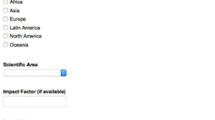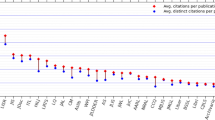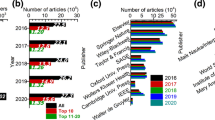Abstract
Impact factors are a widely accepted means for the assessment of journal quality. However, journal editors have possibilities to influence the impact factor of their journals, for example, by requesting authors to cite additional papers published recently in that journal thus increasing the self-citation rate. I calculated self-citation rates of journals ranked in the Journal Citation Reports of ISI in the subject category “Ecology” (n = 107). On average, self citation was responsible for 16.2 ± 1.3% (mean ± SE) of the impact factor in 2004. The self-citation rates decrease with increasing journal impact, but even high impact journals show large variation. Six journals suspected to request for additional citations showed high self-citation rates, which increased over the last seven years. To avoid further deliberate increases in self-citation rates, I suggest to take journal-specific self-citation rates into account for journal rankings.
Similar content being viewed by others
References
Adam, D. (2002), The counting house. Nature, 415: 726–729.
Agrawal, A. A. (2005), Corruption of journal impact factors. Trends in Ecology and Evolution, 20: 157.
ANON (2001), Statgraphics Plus for Windows, ver. 5.1. Manugistics, Rockville, MD, USA.
ANON (2004), R: a language and environment for statistical computing. R Foundation for Statistical Computing, Vienna, Austria. (URL http://www.R-project.org/ )
Baylis, M., Gravenor, M., Kao, R. (1999), Sprucing up one’s impact factor. Nature, 401: 321–322.
Campanario, J. M., Gonzalez, L. (2006), Journal self-citations that contribute to the impact factor: documents labeled “editorial material” in journals covered by Science Citation Index. Scientometrics, 69: 365–386.
Editor’s Note (2005), Trends in Ecology and Evolution, 20: 157.
Garfield, E. (1999), Journal impact factor: A brief review. Canadian Medical Association Journal, 161: 979–980.
Hemmingsson, A., Edgren, J., Mygind, T., Skjennald, A. (2002b), Impact factors in scientific journals. Journal of Magnetic Resonance Imaging, 15: 619.
Hemmingsson, A., Mygind, T., Skjennald, A., Edgren, J. (2002a), Manipulation of impact factors by editors of scientific journals. American Journal of Roentgenology, 178: 767.
King, D. A. (2004), The scientific impact of nations. Nature, 430: 311–316.
Kokko, H., Sutherland, W. J. (1999), What do impact factors tell us? Trends in Ecology and Evolution, 14: 382–384.
Kurmis, A. P. (2003), Understanding the limitations of the journal impact factor. Journal of Bone and Joint Surgery-American Volume, 85: 2449–2454.
Lawrence, P. A. (2003), The politics of publication. Nature, 422: 259–261.
Leimu, R., Koricheva, J. (2005), What determines the citation frequency of ecological papers? Trends in Ecology and Evolution, 20: 28–32.
Monastersky, R. (2005), The number that’s devouring science. The Chronicle of Higher Education, 52: A12. (14 October 2005; http://chronicle.com/free/v52/i08/08a01201.htm)
Nussey, D. H., Clutton-Brock, T. H., Elston, D. A., Albon, S. D., Kruuk, L. E. B. (2005), Phenotypic plasticity in a maternal trait in red deer. Journal of Animal Ecology, 74: 387–396.
Opthof, T. (1997), Sense and nonsense about the impact factor. Cardiovascular Research, 33: 1–7.
Partain, C. L., Fullerton, G. D. (2002), Editor’s Note. Journal of Magnetic Resonance Imaging, 15: 619.
Rogers, L. F. (2002), From the editor’s notebook; impact factor: the numbers game. American Journal of Roentgenology, 178: 541–542.
Rousseau, R. (1999), Temporal differences in self-citation rates of scientific journals. Scientometrics, 44: 521–531.
Snyder, H., Bonzi, S. (1998), Patterns of self-citation across disciplines. Journal of Information Science, 24: 431–435.
Wong, B. B. M., Kokko, H. (2005), Is science as global as we think? Trends in Ecology and Evolution, 20: 475–476.
Author information
Authors and Affiliations
Corresponding author
Rights and permissions
About this article
Cite this article
Krauss, J. Journal self-citation rates in ecological sciences. Scientometrics 73, 79–89 (2007). https://doi.org/10.1007/s11192-007-1727-7
Received:
Published:
Issue Date:
DOI: https://doi.org/10.1007/s11192-007-1727-7




